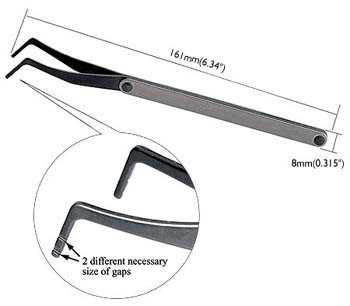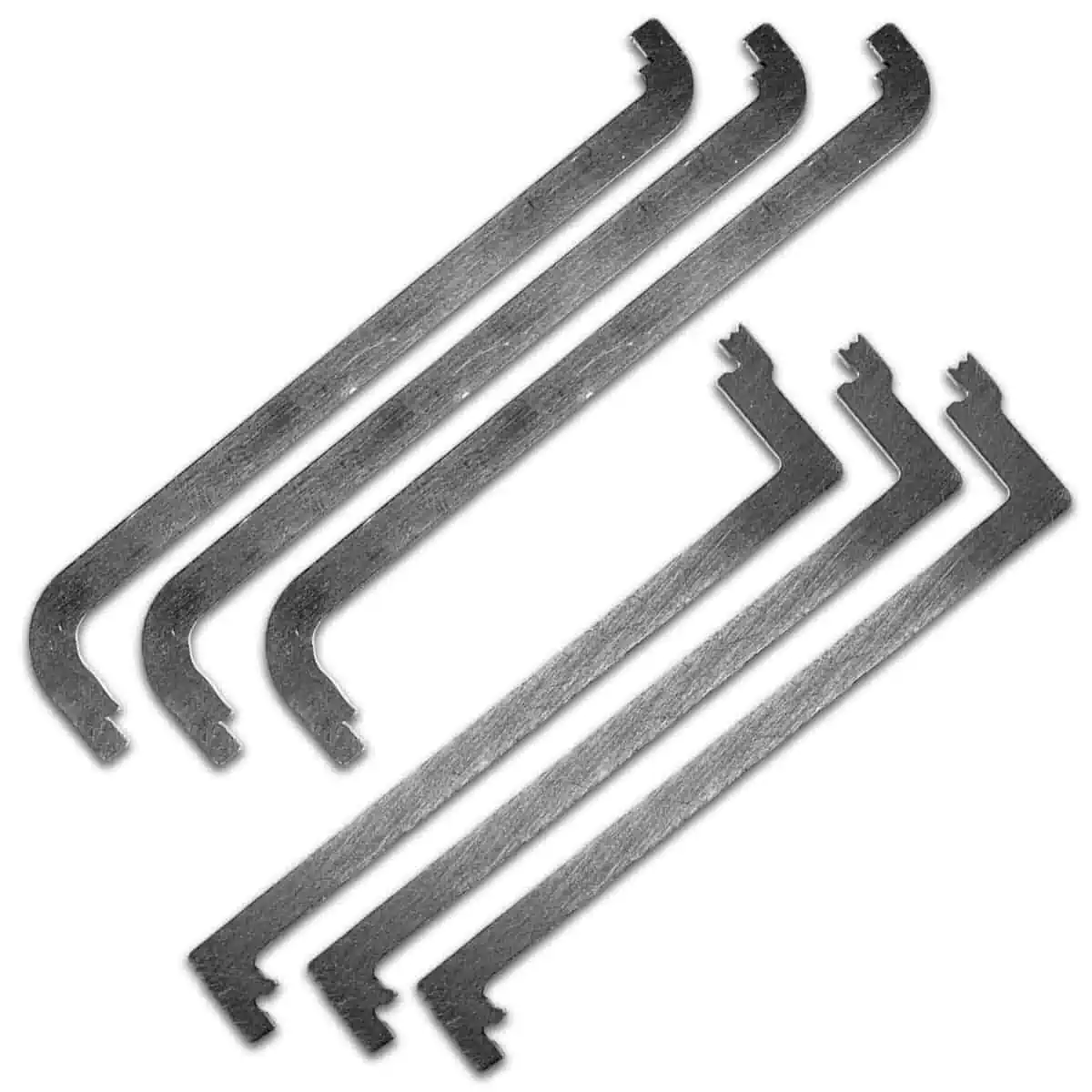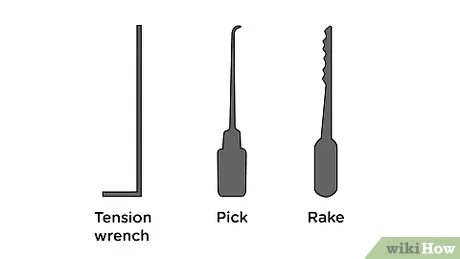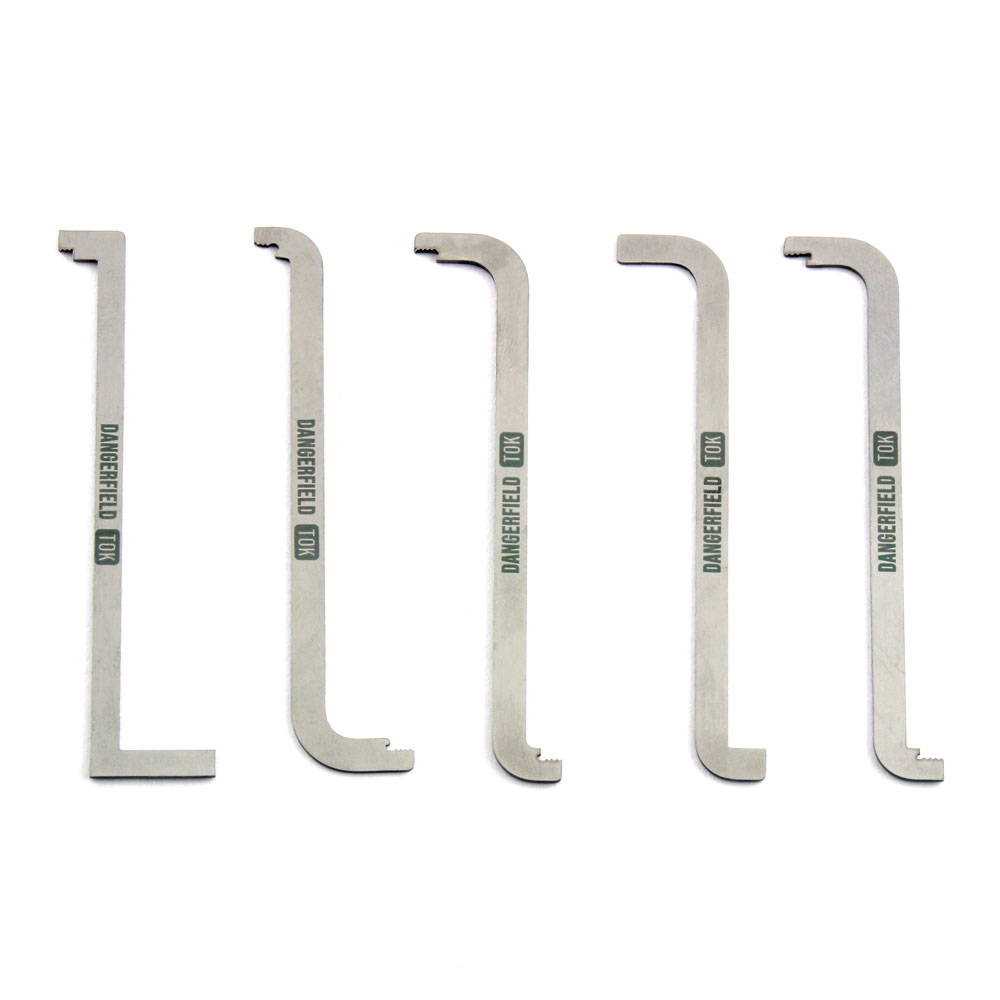What is a Tension Wrench: A Complete Guide to Lock Picking Tools

Lock picking is a skill that has been used for centuries, with its roots dating back to ancient Egypt and Rome. Today, it is often associated with illegal activities, but lock picking can also be a valuable skill for locksmiths, law enforcement, and security professionals. One of the most important tools in a lock picker’s arsenal is the tension wrench.
A tension wrench, also known as a torsion tool, is a small, L-shaped piece of metal that is used to apply pressure to the lock’s core, or plug. This pressure is crucial for manipulating the lock’s pins and allowing them to move freely. Without a tension wrench, it would be nearly impossible to pick a lock.
There are several types of tension wrenches available, each designed for different types of locks and picking techniques. The most common types include the bottom of the keyway (BOK) wrench, top of the keyway (TOK) wrench, and the twisted wrench. BOK wrenches are inserted into the bottom of the keyway, while TOK wrenches are inserted into the top.
Choosing the right tension wrench is essential for successful lock picking. Factors such as the lock’s design, size, and level of security all play a role in determining which tension wrench to use. Additionally, a lock picker must also consider their own skill level and experience when selecting a tension wrench.
Understanding Lock Picking Tools
Lock picking tools are essential for anyone interested in the art of lock picking. These tools are designed to manipulate the internal components of a lock to gain unauthorized access. It is important to understand the various types of lock picking tools and how they are used.
Tension Wrench
The tension wrench is one of the most important tools in a lock picker’s arsenal. It is used to apply torque or tension to the lock cylinder. This is necessary to bind the internal components of the lock and create a shear line, allowing the lock to be manipulated and opened.
Pick Tools
Pick tools are used to manipulate the individual pins or tumblers within the lock cylinder. There are several types of pick tools, including:
- Hook Picks: These picks have a hook-shaped tip that is used to lift the pins within the lock.
- Rake Picks: Rake picks have multiple ridges that are used to quickly manipulate the pins within the lock.
- Diamond Picks: These picks have a diamond-shaped tip that can be used to lift pins individually or rake the entire lock.
- Ball Picks: Ball picks have a round tip that is used to push the pins up into the lock cylinder.
Key Extractors
Key extractors are used to remove broken or stuck keys from the lock cylinder. These tools have a hook or claw-like design that can catch onto the broken key and pull it out.
Practice Locks
Practice locks are an important tool for beginners learning the art of lock picking. These locks are specifically designed to be easily manipulated and are used to develop the necessary skills and techniques.
Other Tools

In addition to the main lock picking tools mentioned above, there are other tools that can be used to assist in the process, such as:
- Tension tools: These tools are used to hold the tension wrench in place and provide a more stable grip.
- Turning tools: Turning tools are used to turn the lock cylinder and apply torque or tension. They can come in various shapes and sizes to fit different types of locks.
- Lock pick sets: These sets contain a variety of pick tools, tension wrenches, and other accessories necessary for lock picking.
- Lock pick guns: Lock pick guns use a vibrating motion to quickly manipulate the pins within the lock and open it.
It is important to note that lock picking should only be performed on locks that you own or have explicit permission to pick. Lock picking is considered a form of trespassing if done without permission.
The Importance of a Tension Wrench
A tension wrench is an essential tool for lock picking. It is used in combination with a lock pick to apply torque or tension to the lock cylinder, allowing the lock to be manipulated and opened.
1. Creating Tension:
When a tension wrench is inserted into the bottom of the keyway, it provides pressure on the lock cylinder, simulating the tension that would be applied by a key turning in the lock. This tension is necessary to properly manipulate the internal pins and shear line of the lock.
2. Sensing Feedback:
The tension applied by the wrench allows the lock picker to sense feedback from the lock. As the pins are manipulated, they will bind and set at the shear line. The tension wrench helps to detect these changes in the lock mechanism by providing resistance or subtle movement when a pin is set.
3. Control and Precision:
The tension wrench allows for control and precision during the lock picking process. By applying the right amount of tension, the lock picker can manipulate the pins one by one, carefully setting them at the shear line without over-tensioning the lock.
4. Compatibility and Versatility:
Tension wrenches are available in various shapes and sizes to fit different types of locks. They can be used with both pin tumbler locks and wafer locks, making them versatile tools for a wide range of lock picking scenarios.
5. Essential for Beginners and Professionals:
Whether you are a beginner or a professional locksmith, a tension wrench is an indispensable tool for lock picking. It is one of the first tools you should become familiar with and master, as it plays a crucial role in successfully picking locks.
Overall, the tension wrench is a vital tool for any lock picker. It provides the necessary tension and control for manipulating lock mechanisms and is a staple in any lock picking toolkit.
Types of Tension Wrenches
A tension wrench is an essential tool used in lock picking to apply tension to a lock’s plug while manipulating the pins. There are several types of tension wrenches available, each with its own unique design and purpose. Here are some common types of tension wrenches:
1. L-Shaped Tension Wrench
The L-shaped tension wrench is one of the most commonly used types. It has a simple design, with one end resembling an L shape. This end is inserted into the keyway, and the other end is held by the picker to apply tension. The L-shaped tension wrench provides a good grip and allows for precise control over the tension applied.
2. Warded Tension Wrench
A warded tension wrench is specifically designed for use with warded locks. It features a narrow, flat end that fits into the keyway, while the other end is held by the picker. The flat end of the wrench is used to push on the lock’s wards, allowing the picker to turn the lock. Warded tension wrenches come in various sizes to accommodate different types of warded locks.
3. Double-Ended Tension Wrench
A double-ended tension wrench has two different ends, each with a different shape or size. This type of wrench offers versatility, as it can be used with a wider range of locks. The picker can choose the end that fits the lock’s keyway best. Double-ended tension wrenches are often made of flexible material, allowing them to be bent and adjusted to fit different lock types.
4. Feather Tension Wrench
A feather tension wrench, also known as a twist flex wrench, is made of thin, flexible metal. It has a thin, flat end that is inserted into the lock’s keyway. The other end is held by the picker to apply tension. The flexibility of the feather tension wrench allows for a delicate touch and precise tension control. This type of wrench is commonly used for delicate or high-precision locks.
5. Light Tension Wrench
A light tension wrench is a thin, flat tool used for applying light tension to the lock while picking. It is usually made of a springy material, such as stainless steel. The light tension wrench is ideal for sensitive locks that require a gentle touch. With this type of wrench, the picker can feel the movement of the pins more easily, increasing the chances of success.
6. Torsion Bar Tension Wrench
A torsion bar tension wrench, also known as a snake rake wrench, is a versatile tool designed for quick and efficient lock picking. It has a curved shape and is inserted into the keyway like a snake rake. The end of the wrench is held by the picker to apply tension, while the curved shape helps to manipulate the pins rapidly. Torsion bar tension wrenches are popular among professional locksmiths due to their speed and effectiveness.
These are just a few examples of the many types of tension wrenches available. Depending on the lock type and the picker’s preference, different wrenches may be used to achieve the desired result. It’s essential to choose the right tension wrench for the task at hand to increase the chances of successfully picking a lock.
Using a Tension Wrench Effectively
The tension wrench is a crucial tool in lock picking that is used to apply rotational pressure to the lock cylinder. It is used in conjunction with a lock pick to manipulate the lock components and ultimately unlock the mechanism.
Choosing the Right Tension Wrench

When selecting a tension wrench, it is important to consider the type of lock you are working on. Different locks may require different types of tension wrenches to effectively apply torque. There are various types of tension wrenches available, including:
- Standard tension wrench: This is the most commonly used tension wrench and is suitable for most locks with a keyway.
- Top of keyway tension wrench: This type of tension wrench is inserted into the top of the keyway and provides more control and stability.
- Bottom of keyway tension wrench: This tension wrench is inserted into the bottom of the keyway and is ideal for narrow keyways.
It is important to choose a tension wrench that fits snugly into the keyway without excessive wiggle or play.
Applying the Right Amount of Tension
When using a tension wrench, it is crucial to apply the right amount of pressure to the lock cylinder. Too much pressure can cause the lock pins to bind, making it difficult to manipulate them with the lock pick. On the other hand, too little pressure will not provide enough torque to turn the lock.
It is recommended to start with light to moderate tension and then gradually increase the pressure if necessary. Experiment with different levels of tension until you find the sweet spot where the lock pins can be easily manipulated.
Adjusting Tension while Picking

As you manipulate the lock pins with the lock pick, you may need to adjust the tension applied by the tension wrench. Slight adjustments can help overcome any resistance or binding you encounter while picking the lock.
It is important not to release all the tension when adjusting – rather, make small, controlled adjustments to maintain the pressure on the lock cylinder.
Practice and Patience
Using a tension wrench effectively requires practice and patience. It takes time to develop the initial feel and touch required to apply the right amount of tension. However, with practice, you will become more comfortable and proficient in using the tension wrench, resulting in successful lock picks.
Remember to always make sure you have the proper authority and permission before attempting to pick a lock. Lock picking should only be used for legitimate purposes.
Common Mistakes when Using a Tension Wrench

- Using too much pressure: One of the most common mistakes beginners make when using a tension wrench is applying too much pressure. Applying excessive force can cause the tension wrench to slip or break, resulting in a failed attempt to pick the lock. It is important to apply just enough pressure to create tension without exerting too much force.
- Using the wrong sized wrench: Another mistake is using a tension wrench that is either too small or too large for the lock being picked. Using the wrong size can make it difficult to create the right amount of tension, resulting in a failed attempt. It is important to use a tension wrench that fits snugly into the keyway of the lock.
- Not applying consistent pressure: When using a tension wrench, it is crucial to apply consistent pressure throughout the picking process. Failing to do so can lead to the pins resetting or binding, making it difficult to successfully pick the lock. It is important to maintain a steady and constant level of pressure to keep the lock’s pins in the correct position.
- Using the wrong technique: Picking a lock with a tension wrench requires a specific technique. Many beginners make the mistake of not using the correct technique, such as not applying tension while manipulating the pins or not using the correct picking motion. It is important to familiarize yourself with the proper picking technique and practice it until it becomes second nature.
- Not using the proper tools: Using the wrong type of tension wrench can greatly hinder your ability to pick a lock successfully. There are different types of tension wrenches available, such as top-of-the-keyway (TOK) wrenches and bottom-of-the-keyway (BOK) wrenches. Each type has its own advantages and disadvantages, so it is important to choose the right tool for the job.
Troubleshooting Tips for Tension Wrenches
- Ensure proper fit: One common issue with tension wrenches is that they may not fit properly in the lock. Make sure that the wrench you are using fits snugly into the keyway. If it is too loose or too tight, it may not provide the necessary tension to the lock mechanism.
- Choose the right tension: Tension is crucial when picking a lock, and different locks require different amounts of it. If you are having difficulty turning the lock, try adjusting the tension. Start with a light amount of tension and gradually increase it until you find the sweet spot where the lock begins to give.
- Use the right technique: The technique you use when applying tension can also affect the success of your lock picking attempt. Make sure you are applying consistent, even pressure with the tension wrench. Avoid excessive force or jerky movements, as this can damage the lock or cause the pins to bind.
- Check for binding pins: If you are having trouble turning the lock, it could be due to binding pins. These are pins that are caught or stuck in the keyway, preventing the lock from rotating. Gently wiggle the tension wrench while applying pressure to see if any pins are binding. If you feel resistance or hear a clicking sound, this may indicate binding pins. Release tension slightly and try to set the binding pins by gently lifting them with a lock pick.
- Clean and lubricate the lock: Over time, dirt, debris, and rust can accumulate in the lock, causing it to become stiff and difficult to pick. If you are having consistent trouble with a particular lock, try cleaning it with a lock lubricant or penetrating oil. This can help to loosen up any stuck pins or mechanisms, making the lock easier to pick.
Remember, picking locks is a skill that takes practice and patience. If you are not having success with a particular lock, don’t be discouraged. Keep practicing and trying different techniques until you find what works best for you.
Choosing the Right Tension Wrench for Your Needs
When it comes to lock picking, having the right tools is essential. One of the most important tools in a lock picker’s arsenal is the tension wrench. A tension wrench is used to apply torsion or tension to the lock’s plug, allowing the lock picker to manipulate the pins and open the lock. However, not all tension wrenches are created equal, and choosing the right one for your needs is crucial.
Types of Tension Wrenches
There are several types of tension wrenches available, each with its own advantages and disadvantages. Here are a few of the most common types:
- Standard Tension Wrench: This is the most basic type of tension wrench. It has a simple L-shaped design and is suitable for most types of locks.
- Warded Tension Wrench: This type of tension wrench is specifically designed for warded locks. It features a unique shape that allows it to fit into the keyhole and apply tension to the lock.
- Twist Tension Wrench: This tension wrench has a twisted design, which allows it to fit into locks with narrow keyways. It is often used for picking dimple locks.
- Double-Ended Tension Wrench: This type of tension wrench has two ends with different thicknesses or shapes. It provides versatility and can be used for a variety of locks.
Factors to Consider
When choosing a tension wrench, there are several factors to consider:
- Lock Type: Different locks may require different types of tension wrenches. Consider the types of locks you will be picking and choose a tension wrench that is suitable for those locks.
- Keyway Size: The size of the keyway is an important consideration when selecting a tension wrench. Make sure the tension wrench can fit comfortably into the keyway without causing any damage.
- Material: Tension wrenches are typically made from steel or stainless steel. Consider the durability and strength of the material when choosing a tension wrench.
- Comfort: Picking locks can be a time-consuming task, so it’s important to choose a tension wrench that feels comfortable in your hand. Look for tension wrenches with ergonomic handles or grips.
Conclusion
Choosing the right tension wrench is essential for successful lock picking. Consider the types of locks you will be picking, the size of the keyways, the material of the tension wrench, and the comfort of the tool. By taking these factors into account, you can find the perfect tension wrench for your needs and improve your lock picking skills.
Where to Buy Tension Wrenches
If you are interested in getting started with lock picking or are an experienced locksmith looking to add to your tool collection, there are several places where you can buy tension wrenches.
1. Locksmith Supply Stores
One of the best places to buy tension wrenches is at locksmith supply stores. These stores specialize in providing tools and equipment for locksmiths and lock picking enthusiasts. They usually have a wide selection of tension wrenches to choose from, catering to different needs and preferences.
2. Online Retailers
Another convenient option is to purchase tension wrenches from online retailers. There are many websites that sell lock picking tools, including tension wrenches. Online retailers often offer a broader selection of products compared to physical stores, making it easier for you to find the specific tension wrench that suits your needs. Additionally, online shopping allows you to compare prices and read reviews from other customers before making a purchase.
3. Auction Sites
If you are budget-conscious or looking for rare or vintage tension wrenches, auction sites like eBay can be a good option. These sites offer a wide variety of tools, including lock picking tools, sold by individuals from around the world. However, it’s important to exercise caution when buying from auction sites and to carefully research the seller’s reputation before making a purchase.
4. Local Locksmiths
You may also be able to find tension wrenches at local locksmiths in your area. Some locksmiths may sell lock picking tools as a side business or have excess stock they are willing to sell. It’s worth reaching out to them to inquire if they have any tension wrenches available for purchase.
5. Lock Picking Communities
Lock picking communities, both online and in-person, can also be a great resource for finding and buying tension wrenches. These communities often have buy/sell/trade sections where members can post lock picking tools they are looking to sell or exchange with others. Engaging with the lock picking community can also provide you with valuable insights and tips on using tension wrenches effectively.
When purchasing tension wrenches, it’s important to ensure that you are abiding by your local laws and regulations. Lock picking tools may be restricted or regulated in some areas, so make sure to familiarize yourself with the laws in your jurisdiction before making a purchase.
FAQ
What is a tension wrench?
A tension wrench is a tool used in lock picking to apply tension to the lock cylinder.
Why is a tension wrench important in lock picking?
A tension wrench is important in lock picking because it creates tension in the lock cylinder, allowing the lock picker to manipulate the pins and open the lock.
What are the different types of tension wrenches?
There are several types of tension wrenches, including L-shaped tension wrenches, twisted tension wrenches, and top-of-the-keyway tension wrenches.
How do you use a tension wrench?
To use a tension wrench, you insert it into the bottom of the keyway and apply slight pressure in the direction that the lock is supposed to turn.
Are there different sizes of tension wrenches?
Yes, there are different sizes of tension wrenches to fit different types of locks.
Can a tension wrench damage the lock?
If used incorrectly, a tension wrench can potentially damage the lock. It is important to apply the right amount of pressure and use the correct technique when using a tension wrench.
Where can I buy a tension wrench?
Tension wrenches can be purchased online from various lock picking stores and websites.











